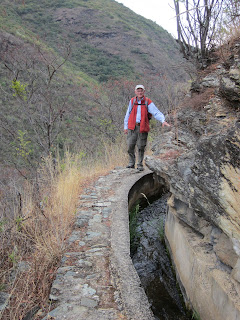
 Atzompa is a village near Oaxaca that, up until recently, was known for it's signature green pottery. It's very poor village, with roots firmly planted in the 7th century. Lately, the income from the green pottery that is made in almost every house in the small village has had been boosted by the ruins at the top of the hill. The state has spent money in the past two years digging and interpreting the ruins of the original Zapotec city, including building a road up to and several parking lots just below the ruins. The work on the site displaced about 100 families who were living close to the top of the hill, but the promise of money from tourism satisfied the town.
Atzompa is a village near Oaxaca that, up until recently, was known for it's signature green pottery. It's very poor village, with roots firmly planted in the 7th century. Lately, the income from the green pottery that is made in almost every house in the small village has had been boosted by the ruins at the top of the hill. The state has spent money in the past two years digging and interpreting the ruins of the original Zapotec city, including building a road up to and several parking lots just below the ruins. The work on the site displaced about 100 families who were living close to the top of the hill, but the promise of money from tourism satisfied the town. The local hiking group in Oaxaca went up there a few weeks ago. There is bus service to the village, but it's a little confusing to find the correct bus, so most of us grouped together to get collectivos, and we met in the small church courtyard. It was a sunny, hot day, and we walked up the hill, past the shacks that are the houses and pottery workshops. Several of us took the shortcut up the mountain, a steeper but short walk to the top.
The Zapotec city of Atzompa was built between the 7th and 9th century, and overlooks one of the three valleys that are home to Oaxaca. It's was not a part of the city of Monte Alban, but a neighbor. The ball court is 45 meters long, significantly larger than the ball court at Monte Alban. Archeologists believe it was the main ball court for the area. It's situated so the players, and likely the viewers, would have a view of the city below. It is a gorgeous location, with gorgeous views across the valley! The state has done a great job with the preservation and presentation of the site. After touring the site, Stuart and I joined about 10 other hikers for lunch in the village, and a quick tour through the pottery mercado.
The potters is ornate, mostly glazed in a lead-free green color. A few pieces are left in the natural color, but the style is distinctively Atzompa.
The next week, three friends, Stuart and I went up to San Augustin Etla for a hike up the aquaduct above that town. Water is a problem in most of the Oaxaca area, but there is a spring above San Augustin Etla that has watered that small village of farmers and small businesses. Again, we caught a collectivo to the church in the center of the puebla, and walked up the hill to the resevoir. That water is NOT clean, coming directly from the mountain top in the hand-made channel, but there is a filter/cleaning process here, and the small mountain of 5 gallon, reusable water bottles outside confirms that our drinking water just might come from here.
About 3 hours up the hill, there is an abandoned electric plant. It used the water from the spring to run the turbines. The shell of the building is pretty, the inside is trash and vandalism-worn. We follow the aquaduct up the hillside, sometimes tight-rope-walking the narrow ledge across a canyon. Along the path we cross a couple of 3-inch pipes the local farmer uses to siphon off water for a small field of corn, onions and squash.
I've hiked this trail several times, and it's always a good hike...the deciduous trees right now are leafless, making the orchids and bromeliads visible. Even something that looks like mistletoe, golden, is growing up here! I don't know what it really is.
I think this vine, pictured directly above, is like the sweet autumn clematis that grows like crazy in southeastern NC.
I spied this nest on the way down...none of us knew what kind of bird it housed, but was abandoned in early February.
A picnic lunch by the creek, at the old electric plant at the top of the mountain...
The hike along the aquaduct is an easy, uphill walk. The long views are not so spectacular, but the walk is good, if you begin early in the day, the birding is probably pretty good. Stuart, coming down the mountain. Another great day in Oaxaca!












No comments:
Post a Comment